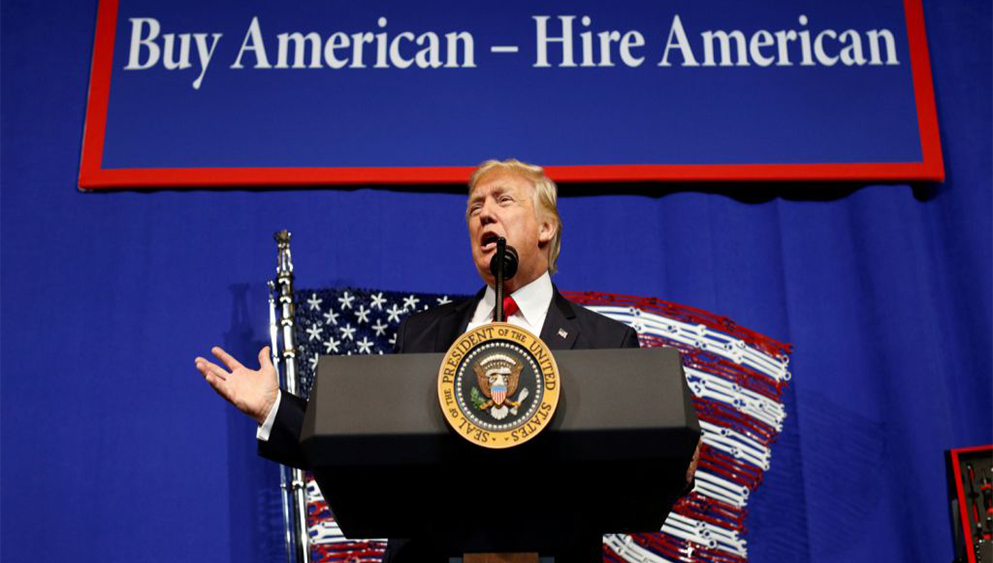President Donald. J Trump Protectionism: Make America Great Again

Trump’s Metal Tariffs and the Looming Threat of a Global Trade War
The Protectionist Turn: Trump’s Steel and Aluminum Tariffs
On March 4, 2018, U.S. President Donald Trump tweeted:
“We are on the losing side of almost all trade deals. Our friends and enemies have taken advantage of the U.S. for many years. Our Steel and Aluminum industries are dead. Sorry, it’s time for a change! MAKE AMERICA GREAT AGAIN!”
The tweet encapsulates Trump’s increasingly protectionist trade agenda, which aims to revive domestic industries through high tariffs on imported metals. The administration announced 25% tariffs on steel and 10% on aluminum, a move that drew immediate backlash from traditional U.S. allies, including the European Union and Canada, as well as strong condemnation from Beijing.
Trump’s approach bears resemblance to the 2002 pre-Iraq invasion steel tariffs, raising concerns about history repeating itself—with global repercussions.
Trade by the Numbers: U.S., EU, and Global Interdependence
According to World Trade Organization (WTO) statistics:
U.S.-EU trade accounts for 14% of U.S. GDP and 17% of EU GDP.
The U.S. contributes 9% of global exports and 14% of imports.
The EU accounts for 15% of global exports and 14% of imports.
The U.S. imports 35 million tons of steel annually, with:
Canada supplying 16%
Brazil 12%
South Korea around 10%
This marks one of the rare moments in recent decades when core allies—like the U.S. and EU—are on the verge of direct retaliatory trade measures.
Risks of Retaliation and a Tariff Spiral
Trump’s move may backfire, both economically and politically. Experts warn that imposing these tariffs will:
Raise domestic steel costs
Potentially trigger a global tariff war
Invite tit-for-tat retaliation, especially from China and India
Increase prices on intermediate goods and consumer products, hurting U.S. industries and households
This contradicts Trump’s own aims under the “Make America Great Again” banner—to create jobs, revive industry, and cut the trade deficit. In fact, historical evidence suggests the last major steel tariffs imposed by the U.S. led to economic downturns and job losses in other sectors.
A Broader Protectionist Trend
The metal tariffs are part of a broader protectionist wave under Trump’s presidency:
The Trans-Pacific Partnership (TPP) was abandoned in the early days of his administration.
Trump continues to push for a restructuring of NAFTA, sounding alarm bells for global trade partners.
Despite the rhetoric of free trade, U.S. trade policy has long been protectionist in practice.
The Myth of American Free Trade
Contrary to the perception of the U.S. as the global champion of free trade, history reveals a pattern of neo-mercantilism:
The “military-industrial complex” is a prime example—open to global investment but protected from foreign competition.
U.S. state apparatus has historically shielded domestic industries from globalization’s full impact.
Both Republican and Democratic administrations have employed protectionist measures:
Ronald Reagan imposed trade barriers on Japan’s auto exports.
George W. Bush introduced steep steel tariffs in 2002.
Barack Obama pursued energy independence, penalized offshoring, and subsidized domestic manufacturing.
Hillary Clinton and Donald Trump, during the 2016 campaign, both criticized multilateral trade deals and emphasized domestic job protection.
Thus, the notion that the U.S. is a pure proponent of free trade is deeply flawed.
Trump’s Agenda: Protectionism on Steroids
While protectionist undercurrents have existed in both parties, Trump’s policies are particularly aggressive, even by Democratic standards. The administration’s actions represent a full-blown return to economic nationalism and could potentially spiral into a global trade conflict.
The biggest concern is that these escalating trade tensions could push the fragile global economy toward recession—at a time when the world faces mounting transnational and geopolitical challenges.
Conclusion: The Cost of Economic Nationalism
Trump’s metal tariffs and trade rhetoric are part of a broader shift away from multilateralism and liberal economic norms. While couched in promises of job creation and industrial revival, the risks are significant:
Retaliation from allies and competitors
Increased costs for U.S. manufacturers and consumers
Global instability in trade relations
A real possibility of a global economic downturn
In a world already beset by complex threats—from climate change to regional conflicts—the global economy is ill-equipped to withstand a protracted trade war. The U.S. may find itself increasingly isolated, not just diplomatically, but economically.
While the rhetoric may score political points domestically, the costs of protectionism—in the form of lost allies, retaliatory measures, and consumer burden—are already mounting. Whether Trump’s trade gamble pays off remains to be seen. But history offers a sobering warning: trade wars have no real winners.
